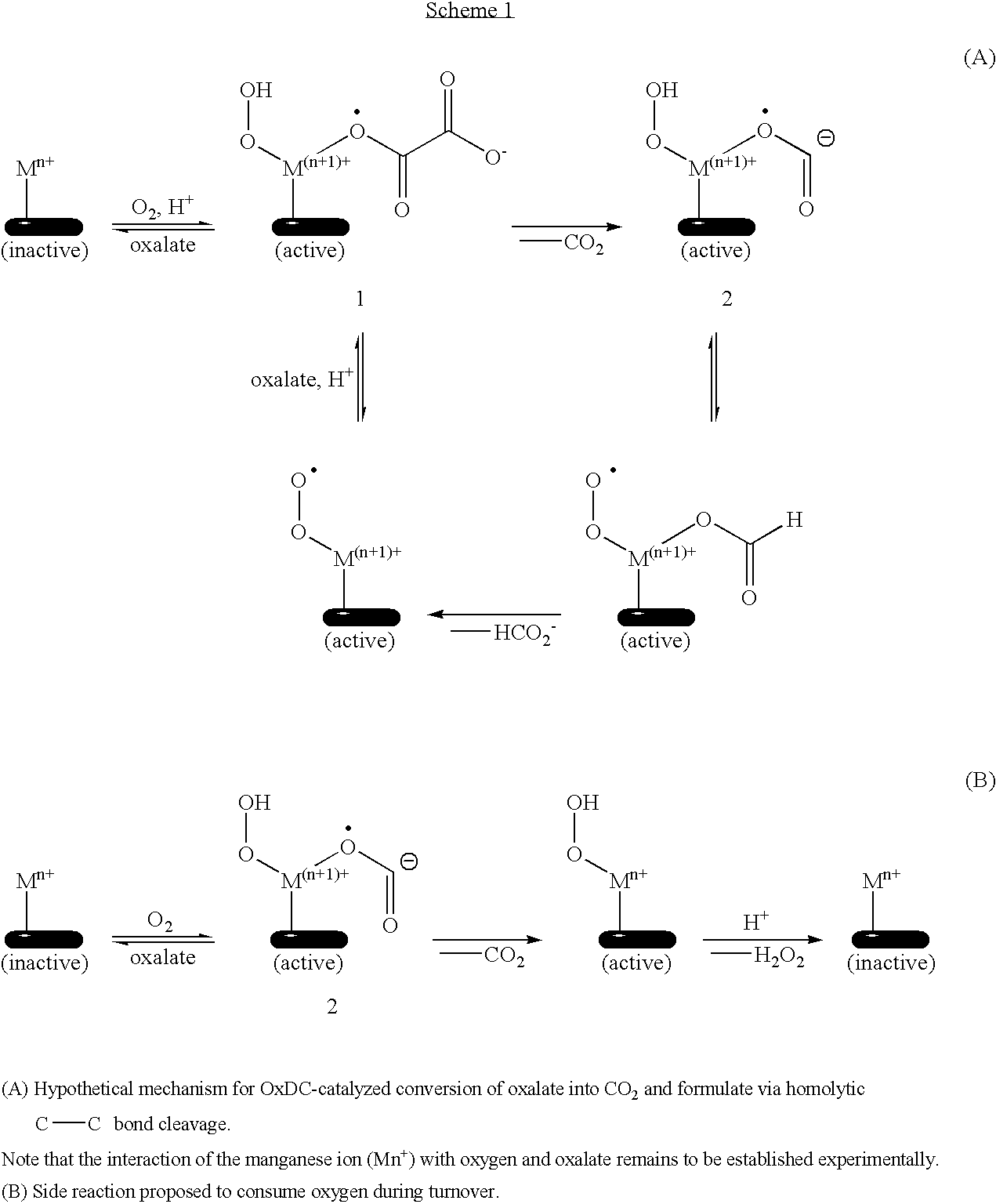Polynucleotides encoding oxalate decarboxylase from Aspergillus niger and methods of use
a technology of oxalate decarboxylase and polynucleotides, which is applied in the field of polynucleotides encoding oxalate decarboxylase from aspergillus niger and methods of use, can solve the problems of difficult formulation of low oxalate diets, difficult compliance with low oxalate diets, and inability to fully understand the catalytic mechanism of oxalate conversion to forma
- Summary
- Abstract
- Description
- Claims
- Application Information
AI Technical Summary
Benefits of technology
Problems solved by technology
Method used
Image
Examples
example 1
Isolation, Purification, and Assay of Native Oxalate Decarboxylase from Aspergillus niger
[0066]Previous studies had shown that the presence of OxDC in the mycelium of Aspergillus niger was inversely related to detectable oxalate in the extracellular milieu (Emiliani et al., 1964). This might be rationalized by assuming that there is leakage of protonated oxalic acid back into the fungus when the pH of the culture drops due to excretion of oxalic and citric acids during the early stages of Aspergillus growth. As a consequence, OxDC expression is induced so as to reduce oxalate concentrations in the mycelium to a non-toxic level. In light of this hypothesis, literature protocols for inducing OxDC production in Aspergillus niger were modified by adding 10 mM sodium oxalate to the minimal media upon which the fungus was grown. Under these conditions, adequate amounts of enzyme could be isolated from the fungal mycelium for the work described here. Previous studies had demonstrated that...
example 2
Deduced Primary Structure of Aspergillus niger OxDC
[0067]Cloning of both the chromosomal and cDNA copies of the OxDC gene showed that (i) there are only two intron sequences in the Aspergillus niger decarboxylase gene (FIG. 3A-3C), in contrast to the 17 reported for the cognate gene in Flammulina velutipes (Kesarwani et al., 2000), and (ii) the intron sequences in the gene encoding OxDC in Aspergillus niger have canonical 5′ and 3′ borders (GT-AG) in contrast to those reported to be present in the cognate gene in Aspergillus phoenices (Scelonge et al., 1998). The protein product encoded by the yvrk gene in Bacillus subtilis (Kunst et al., 1997) shows some homology to Aspergillus niger OxDC with 197 (52%) residues in the bacterial OxDC being identical to those in the fungal enzyme.
[0068]More importantly for the catalytic mechanism of oxalate degradation, there are two “His-TrpHis” motifs that are conserved among the bacterial and fungal oxalate decarboxylases. Recent work on recombin...
example 3
Biochemical Characterization of Native Aspergillus niger OxDC.
[0069]With the successful development of culture conditions and purification procedures to obtain milligram amounts of native Aspergillus niger OxDC, the biochemical and spectroscopic properties of the enzyme were investigated. N-terminal sequencing of the purified protein, carried out at the Protein Core Facility of the Interdisciplinary Center for Biotechnology Research (ICBR) at the University of Florida (UF), revealed that phenylalanine is the first residue in the mature enzyme, the initial N-terminal sequence being Phe-Gln-Asp-Lys-Pro-Phe-Thr-Pro-Asp-His-Arg (SEQ ID NO. 7), matching the primary structure deduced from the cloned genes encoding OxDC in both Aspergillus niger (vide infra) and Aspergillus phoenices (Scelonge et al., 1998) and confirming the identity of the isolated protein. It was anticipated that the N-terminal region would be Tyr-Gln-Gln-Asp (SEQ ID NO. 8) on the basis of the primary structure deduced ...
PUM
| Property | Measurement | Unit |
|---|---|---|
| Mass | aaaaa | aaaaa |
| Mass | aaaaa | aaaaa |
| Mass | aaaaa | aaaaa |
Abstract
Description
Claims
Application Information
 Login to View More
Login to View More - R&D
- Intellectual Property
- Life Sciences
- Materials
- Tech Scout
- Unparalleled Data Quality
- Higher Quality Content
- 60% Fewer Hallucinations
Browse by: Latest US Patents, China's latest patents, Technical Efficacy Thesaurus, Application Domain, Technology Topic, Popular Technical Reports.
© 2025 PatSnap. All rights reserved.Legal|Privacy policy|Modern Slavery Act Transparency Statement|Sitemap|About US| Contact US: help@patsnap.com



